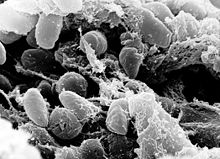Yersinia
| Yersinia | |
|---|---|
 |
|
| Scientific classification | |
| Kingdom: | Bacteria |
| Phylum: | Proteobacteria |
| Class: | Gammaproteobacteria |
| Order: | Enterobacteriales |
| Family: | Enterobacteriaceae |
| Genus: |
Yersinia van Loghem, 1944 |
| Species | |
|
|
Yersinia is a genus of bacteria in the family Enterobacteriaceae. Yersinia species are Gram-negative, rod-shaped bacteria, a few micrometers long and fractions of a micrometer in diameter, and are facultative anaerobes. Some members of Yersinia are pathogenic in humans; in particular, Y. pestis is the causative agent of the plague. Rodents are the natural reservoirs of Yersinia; less frequently, other mammals serve as the host. Infection may occur either through blood (in the case of Y. pestis) or in an alimentary fashion, occasionally via consumption of food products (especially vegetables, milk-derived products, and meat) contaminated with infected urine or feces.
Speculations exist as to whether or not certain Yersinia can also be spread by protozoonotic mechanisms, since Yersinia species are known to be facultative intracellular parasites; studies and discussions of the possibility of amoeba-vectored (through the cyst form of the protozoan) Yersinia propagation and proliferation are now in progress.
An interesting feature peculiar to some of the Yersinia bacteria is the ability to not only survive, but also to actively proliferate at temperatures as low as 1–4°C (e.g., on cut salads and other food products in a refrigerator). Yersinia bacteria are relatively quickly inactivated by oxidizing agents such as hydrogen peroxide and potassium permanganate solutions.
...
Wikipedia
